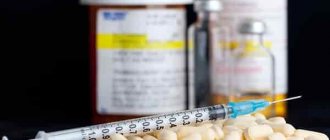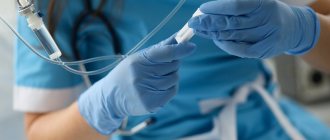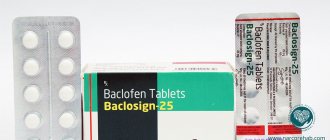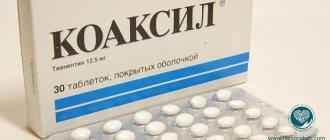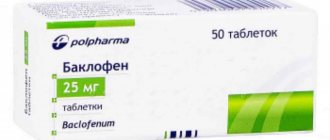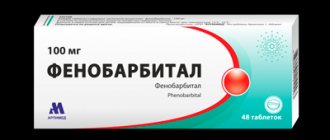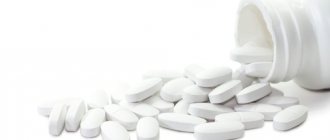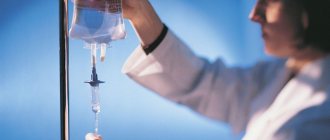- General information
- Historical facts
- Effect on the body
- How to recognize a drug addict
- Tests for tramadol
- How long does it stay in the body?
- How long do drug addicts live?
- Analogs
- How to speed up elimination at home
- Detoxification in hospital
- Overdose
- How to recognize
- First aid
- Rehabilitation
- Coding
- Why you can’t undergo rehabilitation at home or on an outpatient basis
- Working with codependents
- How to quit on your own
- Resocialization
Attention! Drug use causes irreparable harm to health and poses a danger to life!
General information
The drug is marketed under the name Tramadol or Tramal. Both medications have the same effect and can cause physical dependence. By their structure, these are synthetic opiates that were synthesized for medical purposes.
Tramadol is used to relieve severe pain when there is no effect from non-narcotic analgesics. Indications for prescribing it as an anesthetic are the following conditions:
- Injuries involving bone or soft tissue damage.
- Severe somatic pain.
- Oncology stages 3-4, when severe pain occurs due to tumor growth and spread of metastases. In such cases, Tramal can be part of complex pain therapy.
- Carrying out operations in surgical and traumatology practice.
The official instructions indicate that the drug has many side effects, can affect the patient’s consciousness, slow down the reaction and cause withdrawal symptoms after the end of the effect. Recommended age of appointment is after 14 years.
Tramadol has been used for recreational purposes for more than 30 years. Moreover, some drug addicts who switched to heroin or other opiates started with Tramadol or its analogues.
The distribution of the drug became possible due to its frequent use in medicine. This resulted in Tramal becoming a very accessible drug and could be purchased for relatively little money. As a result, the release of Tramadol has been limited in the Russian Federation and is now available only by prescription.
If you use high doses of tramadol in order to get drug intoxicated, then addiction develops within just a few doses.
Like any other opiates, tramadol causes depression of the respiratory center. Drug addicts for recreational purposes use doses 3-5 times higher than pharmaceutical doses. This often causes overdose and death.
Effect of tramadol
The main constituent substance is tramadol hydrochloride. Its amount depends on the form of release of the medicine. In addition, the composition contains magnesium stearate, sodium acetate, milk sugar, distilled water.
When taking the drug, pleasure receptors are stimulated, pain is reduced, and sensations are dulled. A person feels comfortable and cozy, all problems recede. Very often, tramadol is abused by people prone to increased anxiety and neuroses.
Tramadol as a narcotic is used for pain relief, and the effect is felt within a few minutes. Its effectiveness is less than that of morphine, so drug addicts often take it in large doses, remaining in a state of euphoria for up to 36 hours. The following signs are characteristic of drug intoxication:
- lack of aggression, goodwill towards everyone;
- cheerfulness;
- excessive impressionability and responsiveness;
- desire for communication, swagger.
Long-term use of tramadol causes fear of loneliness, persecution mania, nightmares at night, and hallucinations.
History of creation
The drug was invented by Kurt Flick. This German chemist was involved in research in the field of synthetic opiates. His goal was to create a drug with strong analgesic activity and minimal side effects.
Tramadol first appeared on the market in the early 60s of the last century. In many Asian countries, tramadol is sold without a prescription, so pharmacy drug addiction is very common there.
Over the entire history of the drug, the number of prescriptions written for tramadol exceeds 70 million.
About a third of the forms were issued for non-medical purposes. Sometimes patients deceive doctors in order to obtain a prescription.
Effect on the body
The effect of tramadol is similar to opiates, only less pronounced. In small doses, which are recommended by the pharmacological company and doctors, the drug has no special side effects and is rarely addictive. But if you increase the dose and frequency of administration, then along with drug intoxication, changes appear in the functioning of the central nervous system and internal organs. Tramadol is a toxic drug; it can destroy liver hepatocytes, disrupt creatinine clearance in the kidneys and lead to disruption of communication between brain neurons.
The action of Tramal is based on stimulation of opioid receptors. This leads to depression of the central nervous system, severe analgesia, and impaired perception of time and space. CNS depression leads to a slowdown in the transport of ions across neuronal membranes. The consequence of this is loss of pain sensitivity.
When used for recreational purposes, the changes in the body are completely different and can lead to death.
Physical symptoms
Consequences of taking high dosages of tramadol:
- breathing problems, slowing down and stopping completely;
- slow heart rate, persistent bradycardia;
- drop in blood pressure;
- arrhythmias;
- decreased strength of contractions of striated muscles;
- the appearance of vomiting;
- convulsions;
- tremors in the hands;
- profuse sweating, after which body temperature may decrease;
- the appearance of jaundice;
- slower peristalsis, constipation;
- decrease in the amount of urine per day;
- constriction of the pupils (only 2 small dots of very small diameter may remain).
Cognitive changes
What happens to a person after taking the substance:
- memory impairment;
- disturbance of sleep processes;
- the appearance of illusions or hallucinations;
- decreased intellectual abilities;
- disorientation;
- increased drowsiness;
- the appearance of incoherent speech;
- change in behavior during the period when the drug ends.
It should be understood that all effects are dose dependent. The higher the dose, the more pronounced the symptoms and the greater their number. Usually, few symptoms appear from the first doses of the drug, but with each subsequent use the dose of tramadol increases and, accordingly, the consequences for the body will be worse.
Tramadol: effect and side effects
Drug addicts use this drug to obtain the following effects of tramadol:
- improving mood, achieving a feeling of euphoria;
- eliminating the feeling of fatigue;
- relief of pain of varying intensity;
- elimination of anxiety syndrome, smoothing symptoms of depression;
- change in perception of reality.
- For obtaining a short-term narcotic effect, drug addicts have to pay with irreversible consequences for internal organs and serious illnesses, and sometimes with their own lives.
When using this drug for medical purposes, the side effects of tramadol are minimal.
As the dose increases, their number increases many times over. The following symptoms are typical for a tramadol overdose:
- decreased blood pressure;
- depression of the respiratory center;
- dizziness;
- drowsiness;
- nausea, vomiting;
- muscle hypotonia;
- decreased intelligence and memory;
- disorientation in space and time;
- constriction of the pupils;
- slow heartbeat;
- increased blood viscosity;
- toxic damage to hepatocytes, etc.
How to recognize a drug addict
The dose of tramadol is usually increased gradually until a person experiences an overdose or clear signs of toxic damage to organs and the central nervous system, requiring months of active use. This complicates the early diagnosis of tramadol addiction.
To suspect a person of abusing narcotic analgesics, you should always pay attention to his behavior and changes in mood over time. The fact is that such people are always in two states: under the influence of a drug and in a state of withdrawal.
In the first case, people experience lethargy, drowsiness, indifference to the world around them, and calmness. Sometimes on the contrary, they can be very active, sudden mood swings occur.
During the abstinence period, these are always aggressive and apathetic people. They are anxious, in search of a new dose, can be rude and even resort to physical force. They often take money from loved ones, steal jewelry, and take household appliances out of the house.
With tramadol addiction, without a new dose, withdrawal occurs. It manifests itself with convulsions and severe pain. Typically, such symptoms last from 2 to 7 days.
Detoxification
3 000 ₽
Calling a narcologist to your home
3 000 ₽
Another “bell” that your loved one may be abusing drugs is the appearance in his room or belongings of packages of medications, prescription forms and receipts from pharmacies.
The effect of the drug lasts approximately 120-180 minutes. But it all depends on the dose and method of use. If taken intravenously, the substance acts more intensely, but for less time. When using pills, the opposite is true.
All addicted people begin to experience difficulties with work or study. This is due to the fact that the volitional sphere is violated. A person cannot bring himself to go to class or show up at work on time. In addition, cognitive functions suffer, which makes such people poorly trained and slow workers.
Coding
Coding is a non-evidence-based treatment for any addiction. Coding is based on hypnosis, psychological pressure or intimidation of patients. This may work on psychologically weak people, children or people without physical addiction.
In other cases, neither fear nor hypnosis can force a person not to take a new dose. Therefore, you should not use coding in cases of drug addiction. It is absolutely ineffective, but costs a lot of money. Nowadays, coding is done by charlatans.
Tests for tramadol
There are two options for testing a person who has used tramadol or tramal: they can determine the amount of the drug used and the fact of its use. In the second case, the enzyme immunoassay method is used, which is the main one in rapid tests.
They sell tests that are specific to synthetic opiates. This means that they will be positive even if you take other drugs with a similar active substance and mechanism of action. Typically, such tests have more than 99% accuracy, but it is difficult to determine which drug gave a positive reaction.
Such tests cannot be used in legal proceedings as they are not certified. The average price of such a test is from 150 rubles. The second option for such tests is test plates. Such tablets, interacting with biological fluid, can help determine the use of 5-10 drugs. This makes sense, since drug addicts typically suffer from polydrug addiction and use whatever they can find or buy. A person who uses only tramadol for recreational purposes is rare.
Quantitative testing methods are laboratory studies using chromatography, gas-liquid spectrometry, gas chromatography-mass spectrometry. These tests can be used in legal proceedings. They show the amount of the drug used and the approximate time frame when the drug was last used.
Among the rapid tests there are few fakes and they are all relatively high quality. You can buy tests from such and “Wondfo”;
You can use saliva, blood, and urine for testing. Urine is the most optimal biological fluid because it can be easily and safely obtained from the patient. Blood and saliva testing are more expensive and take longer.
How long does it stay in the body?
On average, tramadol is cleared from the body within 72 hours. But you need to understand that everything depends on the patient’s age, weight, drug use experience, functional characteristics of the liver and kidneys. Because everything is very individual.
According to data, tramadol metabolites can be detected in the blood within 24-48 hours. But after 12-14 days you can try to find antibodies produced against antigens from tramadol metabolism.
The drug stays in the urine for about 3 days. In saliva for up to 6 hours. Parts of the metabolites may remain in the hair for several months. But in our realities, checking hair or nails is a very long (up to a month) and expensive process.
In practice, blood testing and conventional immunochromic urine tests are used. This makes it possible to identify drug addicts and, if necessary, remove them from work in order to begin treatment.
You can't cheat the test. An experienced doctor knows that urine collection must be done under control, and blood must be taken from the cubital vein in an amount of 10 to 20 ml.
How to use Tramadol: instructions
The drug is prescribed by a doctor in short courses as a symptomatic remedy. The regimen of use and dosage depend on the physical condition and age of the patients.
- Instructions for oral solution: patients over 14 years old - 20 drops with a spoon of sugar or water, 1 time per day. If necessary, it is allowed to repeat the dose after 1–2 hours. Children under 14 years of age: at the rate of 1 mg. per 1 kg. body weight.
- Tablets and capsules are taken with water, before or after meals. Daily dose: 50 mg. For severe pain, an increase to 400 mg is possible.
- Tramadol injections are given subcutaneously, intravenously or intramuscularly. Before administration, the contents of the ampoules are diluted in saline solution. Daily doses of the drug vary from 50 to 400 mg. Time intervals between injections: 4–6 hours.
- Suppositories are used rectally, introducing 1 piece. from 1 to 4 times a day.
Elderly people suffering from reduced liver or kidney function are recommended to reduce the dose of Tramadol by half.
How long do drug addicts live?
There are no exact data on life expectancy. Moreover, it is impossible to say whether the person died precisely from tramadol addiction or polydrug addiction, or due to a disruption in the functioning of internal organs.
But as soon as a person becomes dependent, his quality of life immediately deteriorates. All he thinks about and lives for is drugs. Consciousness and behavior change. For the sake of a new dose, drug addicts are ready to commit immoral acts, theft and even murder.
Along with tramadol, they often drink alcohol, other opiates, and smoke cannabis. All this greatly depletes the body, and the lifestyle increases the risk of premature death due to conflicts with other people, crimes and diseases that arise against the background of injections or suppressed immunity.
We can safely say that people who are dependent on opiates rarely live more than 10 years.
The usual cause of death is overdose. Death often occurs during drug-induced sleep. Opiates stimulate the autonomic nervous system and this often results in vomiting. Due to the anesthesia, a person does not feel this and may vomit while sleeping on his back. Vomit enters the respiratory tract and causes asphyxia.
All types of drug addiction
Drug addiction treatment
More details
Female, age, beer
Treatment of alcoholism
More details
Tramadol
(tramadol | tramadol)
Registration number:
P N 015731/01 dated 06/03/2004 Trade name of the drug: Tramadol
International nonproprietary name:
tramadol
Dosage form:
pills
Compound:
1 tablet contains: active substance: tramadol hydrochloride 50 mg Excipients: Lactose, microcrystalline cellulose, magnesium stearate, crospovidone, macrogol 4000, sodium saccharin, colloidal silicon oxide, flavoring.
Description: round, flat, white with barely noticeable inclusions, slightly rough tablets with a chamfer with a characteristic strawberry odor.
Pharmacotherapeutic group:
Analgesic opioid drug ATC code: [N02AX02]
Pharmacological properties:
Pharmacodynamics: The drug belongs to list No. 1 of potent substances of the Standing Committee for Drug Control of the Ministry of Health of the Russian Federation.
An opioid synthetic analgesic that has a central effect and an effect on the spinal cord (promotes the opening of K + and Ca + channels, causes hyperpolarization of membranes and inhibits the conduction of pain impulses), enhances the effect of sedatives. Activates specific opioid receptors (mu-, delta-, kappa-) on the pre- and postsynaptic membranes of afferent fibers of the nociceptive system in the brain and gastrointestinal tract. Pharmacokinetics: After oral administration, it is quickly and almost completely absorbed from the gastrointestinal tract (about 90%). The maximum concentration in blood plasma is determined 2 hours after oral administration. Bioavailability after a single oral dose is 68% and increases with repeated use. Penetrates through the blood-brain and placental barriers. 0.1% is excreted in breast milk. Distribution volume – 306 l. Communication with plasma proteins - 20%. Metabolized in the liver by N- and O-demethylation followed by conjugation with glucuronic acid. 11 metabolites have been identified, of which mono-O-desmethyltramadol (M1) has pharmacological activity. T ½ in the second phase – 6 hours (tramadol), 7.9 hours (mono-O-desmethyltramadol); in patients over 75 years old – 7.4 hours (tramadol); for liver cirrhosis – 13.3 + 4.9 hours (tramadol), 18.5 + 9.4 hours (mono-O-desmethyltramadol), in severe cases – 22.3 hours and 36 hours, respectively; for chronic renal failure (creatinine clearance less than 5 ml/min) – 11 + 3.2 hours (tramadol), 16.9 + 3 hours (mono-O-desmethyltramadol), in severe cases – 19.5 hours and 43.2 hours, respectively . Excreted by the kidneys (25-35% unchanged), the average cumulative renal excretion rate is 94%. About 7% is eliminated by hemodialysis.
Indications for use:
Pain syndrome of moderate and severe intensity of various etiologies (postoperative period, trauma, pain in cancer patients). Anesthesia during painful diagnostic or therapeutic procedures.
Contraindications:
- Hypersensitivity to the drug and other opioids.
- Conditions accompanied by respiratory depression or severe depression of the central nervous system (poisoning with alcohol, sleeping pills, narcotic analgesics, psychotropic drugs).
- Severe liver and/or renal failure (creatinine clearance less than 10 ml/min).
- Simultaneous use of MAO inhibitors (and two weeks after their discontinuation).
- During pregnancy and lactation, use is possible only for health reasons and should be limited to a single dose.
- Children's age (up to 14 years).
The drug should be used with caution and under the supervision of a physician in patients with impaired renal and liver function, with traumatic brain injury, increased intracranial pressure, patients with epilepsy, as well as persons with drug addiction to opioids, in patients with abdominal pain of unknown origin (“ acute stomach").
Directions for use and dosage:
Tramadol is used when prescribed by a doctor; the dosage regimen is selected individually depending on the severity of the pain syndrome and the sensitivity of the patient.
Unless otherwise prescribed, Tramadol should be prescribed in the following dosages: For adults and adolescents over 14 years of age - 1 tablet (50 mg), if necessary, another tablet can be taken after 30-60 minutes; for severe pain, a single dose can be 100 mg (2 tablets). The tablets are swallowed without chewing, washed down with a small amount of liquid, or pre-dissolved in ½ glass of water, regardless of meals. The daily dose should not exceed 400 mg (8 tablets). Higher doses may be used to treat cancer pain and severe pain in the postoperative period. In elderly patients (aged 75 years or more), due to the possibility of delayed elimination, the interval between administration of the drug can be increased in accordance with individual characteristics. In patients with kidney or liver disease, Tramadol may take longer to act. For such patients, the doctor may recommend increasing the interval between single doses. Tramadol should not be prescribed for longer than therapeutically necessary. Side effects: From the cardiovascular system: tachycardia, orthostatic hypotension, syncope, collapse. From the digestive system: dry mouth, nausea, vomiting, flatulence, abdominal pain, constipation, diarrhea, difficulty swallowing. From the nervous system: sweating, dizziness, headache, weakness, increased fatigue, lethargy, paradoxical stimulation of the central nervous system (nervousness, agitation, anxiety, tremor, muscle spasms, euphoria, emotional lability, hallucinations), drowsiness, sleep disturbance, confusion, impaired coordination of movement, convulsions of central origin (with intravenous administration in high doses or with simultaneous administration of antipsychotic drugs), depression, amnesia, impaired cognitive function, paresthesia, gait instability. Allergic reactions: urticaria, itching, exanthema, bullous rash. From the urinary system: difficulty urinating, dysuria, urinary retention. From the senses: impaired vision, taste. From the respiratory system: dyspnea. Other: menstrual irregularities.
With prolonged use - the development of drug dependence. In case of abrupt withdrawal, the development of withdrawal syndrome is possible.
Overdose (intoxication) of the drug: Symptoms: miosis, vomiting, collapse, coma, convulsions, depression of the respiratory center, apnea. Treatment: ensuring airway patency, supporting breathing and the functioning of the cardiovascular system. Opiate-like effects can be relieved with naloxone, and seizures with benzodiazepine.
Interaction with other drugs:
Strengthens the effect of ethanol and drugs that have a depressant effect on the central nervous system. Inducers of microsomal oxidation (including carbamazepine, barbiturates) reduce the severity of the analgesic effect and duration of action. Long-term use of opioid analgesics or barbiturates stimulates the development of cross-tolerance. Anxiolytics increase the severity of the analgesic effect, the duration of anesthesia increases when combined with barbiturates. Naloxone activates breathing, eliminating analgesia after the use of opioid analgesics. MAO inhibitors, furazolidone, procarbazine, and antipsychotics may cause a risk of developing seizures (lowering the seizure threshold). Quinidine increases the plasma concentration of tramadol and reduces the content of the M1 metabolite due to competitive inhibition of the CYP2D6 isoenzyme.
Special instructions:
Tramadol is used at increased intervals in elderly patients.
Under close medical supervision and in reduced doses, tramadol should be used against the background of the effects of anesthesia, hypnotics and psychotropic drugs. It is prohibited to drink alcohol during treatment. Not used for the treatment of drug withdrawal syndrome. In the case of a single dose, there is no need to interrupt breastfeeding. When using the drug, you must refrain from driving a car and engaging in potentially hazardous activities that require increased concentration and speed of psychomotor reactions.
Release form:
10 tablets each in blisters made of Al foil and OPA/Al/PVC combination. 1, 2, 3 or 5 blisters along with instructions for use in a cardboard box.
Storage conditions:
At a temperature not exceeding 25 °C, out of the reach of children. The drug belongs to list No. 1 of potent substances of the Standing Committee for Drug Control of the Ministry of Health of the Russian Federation.
Best before date:
5 years. The drug should not be used after the expiration date.
Conditions for dispensing from pharmacies:
By doctor's prescription.
Analogs
All drugs whose active ingredient is tramadol are its exact analogues. They have the same effect, but different trade names. The quality of the drug depends on the manufacturer. Sometimes another active ingredient is added to these drugs to expand its effect on the body.
There are analogues according to the mechanism of action, these are primarily: methadone, morphine, codeine, promedol, as well as other drugs from the group of narcotic analgesics.
Among drugs, analogues with similar effects are heroin, opium, and desomorphine.
Dosage forms and composition of Tramadol
The active component of the drug is Tramadol hydrochloride. This substance is an opioid agonist and acts on specific receptors in the central nervous system, inhibiting sensitivity to pain. Tramadol is considered an analgesic of mixed action. Available in several forms for local and systemic use:
- Tablets: white coated, scored, in dosages of 50, 100 mg. Packed in blisters, packaged in 10–100 pieces. Excipients in the composition: starch, silicon dioxide, magnesium stearate, MCC.
- Gelatin capsules: 50 mg each, yellowish in color, contain white powder inside the shell.
- Suspension for oral administration: clear sweetish liquid with mint and anise aroma, 1 ml - 100 mg of active ingredient, water, propylene glycol, glycerin, sucrose, flavorings, essential oils. Available in glass bottles
- Solution for injection: with a dosage of 50 mg Tramadol hydrochloride per 1 ml. Water-based, in glass ampoules 1–5 ml.
- Rectal suppositories: fat-based, white torpedo-shaped, packaged in cell blisters. Each suppository contains 100 mg of active substance.
Tramadol Retard tablets are also available with a dosage of up to 200 mg, which have a longer lasting effect.
How to speed up elimination at home
You need to understand that it will not be possible to remove the drug in a couple of hours. The effect can be stopped using opioid receptor antagonists. But given the short-term effect of the drug, they should be used only in case of an overdose of tramadol.
You also need to understand that after all tramadol metabolites are eliminated, withdrawal symptoms may occur. The person will experience convulsions, vomiting, and severe pain in muscles and joints. This occurs because opioid receptors are not stimulated by endogenous opioids. Endogenous opiates are not produced, since exogenous ones (in the form of tramadol) are constantly supplied from the outside.
At home, you need to drink plenty of fluids. Better than sweets, this will feed the brain with glucose. Typically, people experience decreased appetite and exhaustion after using opiates. Sweet tea is a great choice. You can drink coffee, but provided that there are no more than 3 cups, and if there are no problems with the conductivity of the heart muscle.
Minimal activity helps speed up your metabolism. If you dress well while walking, your body temperature will rise, which can increase your metabolism.
You need to eat food that is high in fiber, low in fat and meat. Fried and salty foods negatively affect the liver and peristalsis. And tramadol itself can inhibit the secretion of gastric juice and intestinal motility. Tramadol has a toxic effect on the liver, so during the period of cleansing the body, it should be minimally loaded. Alcohol is strictly prohibited.
Tramadol - medical use
Tramadol is a pharmaceutical drug that was originally synthesized by a German pharmacist in 1962. Selling the drug in pharmacies has become a new milestone in the life of the pharmaceutical company. Since this drug began to be prescribed, most often as an analgesic, not only in Germany, but also throughout the world. The drug Tramadol
Often used at the moment, when a person has acute and chronic diseases. It is often used after surgery or to minimize the suffering of cancer patients.
Detoxification in hospital
In the hospital, infusion is carried out using colloid and crystalloid solutions. The blood is saturated with 5% glucose. This reduces the concentration of drug metabolites and stimulates the kidneys to work.
In order to improve kidney function, loop diuretics are added to treatment. This method of removing toxins is called forced diuresis.
Symptomatic treatment is carried out in the hospital. And in cases of severe withdrawal syndrome, the patient may be put into an artificial coma. This helps to survive withdrawal without consequences. If necessary, antioxidants and hepatoprotectors are prescribed. Hemodialysis and other hardware methods of cleansing the body of drugs are carried out.
Overdose
To get drug intoxication, the drug addict needs to increase the dose each time. This is due to the development of tolerance. The body produces enzymes for every foreign substance. And the more often this substance is supplied, the more resources appear in the body to fight this substance.
Therefore, the same dose of the drug the second time has a weaker effect. Because of this, drug addicts endlessly increase the number of tramadol tablets. As a result, the dose becomes too large for the body to cope with, and rapid dysfunction of all organs and systems occurs.
Often, the combination of tramadol with alcohol or other drugs is an aggravating factor. This increases the risk of overdose several times.
The main manifestations of a tramadol overdose will be the following symptoms:
- disturbance of consciousness in the form of stupor or coma;
- the appearance of frequent vomiting, which does not bring relief;
- convulsions;
- breathing and heartbeat disturbances;
- constriction of the pupils;
- profuse sweating;
- involuntary defecation and urination;
- hallucinations and illusions.
Without help, a patient with an overdose may die.
What to do
Before you begin to provide assistance, you must be sure that you are not in danger. That there are no other people around under the influence of drugs who could harm you. Then call an ambulance, and while it is driving, begin providing first aid.
- Warm the patient if it is cold. Throw a jacket and blanket over him and bring him into the room. If it’s hot, on the contrary, undress him, open the windows, provide fresh air.
- Make sure that the patient does not lie on his back while vomiting. The patient's head should always be turned to the side to prevent vomit from entering the respiratory tract.
- If the patient is conscious, give him sweet tea or coffee. He should drink plenty of fluids. If it's hot outside, you can give cold drinks (alcohol is prohibited).
- If convulsions occur, do not hold the patient or hold his tongue with any objects. Try to place a soft pillow or blanket near the person's head so that he does not injure himself during convulsions.
- If there is no pulse or breathing, perform chest compressions. You need to press firmly on the chest above the solar plexus. You need to press 2 times in 1 second, every 30 presses you need to inhale mouth-to-mouth. Before inhaling, make sure that there is no vomit in the person’s mouth; if there is, clean it with a handkerchief or napkin.
When the ambulance arrives, they can administer an antidote. Usually, doctors do not determine which opiate caused the overdose; they simply administer naloxone. Then symptomatic treatment is carried out and the patient is hospitalized in a hospital for detoxification and maintenance therapy.
Dependence on Tramadol - development and signs
In order to figure out whether Tramadol is a drug or not, you need to know only one thing: after using just one dose of the drug, a person will want to repeat it. To do this, the addict simply needs to eat an additional dose. After this, addiction progresses rapidly and has serious consequences. And the withdrawal period is manifested by terrible side effects:
- First day. After the end of the narcotic effect, a person is tormented by terrible dreams, he feels tired and insatiable, and experiences a fear of loneliness. During this period, psychological dependence begins, when the drug addict needs to take a new dose in order to get rid of the state of panic and discomfort.
- After 7 days, the addict experiences auditory and visual hallucinations, talks with non-existent people, animals, characters from films and books. With all this, hallucinations appear as an interesting, new experience. Because of this, the development of physiological dependence begins.
- After 30 days, psychological dependence becomes more stable, and without pills the addict experiences apathy, anger, dislike for life, panic attacks and other psychological attacks. Physiological signs begin in which the addict does not want to eat, he is thirsty and suffers from constipation. This happens because opioids disrupt the gastrointestinal tract.
- After 90 days, early syndromes also appear and at the same time seriously intensify, but new ones are also added. These include frequent mood swings, crying, regular migraines, high blood pressure, chills. The influence of the psychotropic substance affects the brain - serious problems begin with remembering ordinary things and concentrating.
- At this stage, a person can no longer cope with addiction without outside help. Withdrawal after using Tramadol lasts about a month and occurs with attacks of paranoia, hallucinations, tachycardia and is accompanied by serious headaches.
- 365 days of using tramadol, which is a drug, does not pass without serious problems and consequences. Bones and joints are destroyed. They become weak and the risk of injury increases. The teeth crumble and the bite deteriorates. Constant use of opiates increases the load on the liver, and the development of diseases up to cirrhosis begins. A decrease in immunity manifests itself in such a way that wounds take longer to heal, and the risk of viral and infectious diseases increases. Diseases of the heart and blood vessels begin. Impact on the heart and frequent intravenous administration of the drug develops serious heart failure and vascular inflammation. Serious mental problems also occur. Regular use causes paranoid attacks, hallucinations, severe depression and suicidal thoughts.
Rehabilitation
Rehabilitation of opiate addicts (including narcotic analgesics) requires inpatient treatment. This is primarily due to the appearance of withdrawal symptoms. Only in a hospital can adequate support and pain relief be provided so that the patient survives withdrawal and does not break down.
It should be understood that drug addiction cannot be cured. The task of a narcologist is long-term and stable remission of the patient. The word “remission” refers not only to the absence of drug use, but also to the person’s moral state. He must understand for himself that he is on the right path and he should not have the desire to use the drug again. This is precisely the condition that is the prerogative of professional drug treatment centers.
To achieve such an effect, it is not enough just to survive withdrawal. It is necessary to carry out regular psychological work with the patient. Include his loved ones in the program, help the patient recover in society and completely change his destructive behavior pattern.
Tramadol has a significant effect on the human body.
Moreover, both mental and physical condition suffers. The emotional sensitivity from using this substance is constantly increasing. A drug addict becomes more empathetic towards the people around him. He feels a surge of strength and vigor increases. Another interesting quality that arises in this case is riskiness.
After about a couple of days, the intoxication from the drug goes away. Then serious problems with sleep begin. There is a fear of being alone. Addiction to the drug is characterized by the absence of euphoria after taking it. However, in parallel, there is the emergence of some mania, even paranoia.
The psyche suffers greatly from the use of the drug. After about a week of active use, strong hallucinations begin to appear. A person can often see objects and beings that do not actually exist. They may be following him. Some people even talk to them, considering all this real and very real.
Recognizing a drug addict
Tramadol addiction may have some special manifestations. Of course, the manifestations may be different for each individual person, but there are several general consequences of drug use:
- The appearance of excessive pallor.
- Active weight loss.
- The person begins to consume a significant amount of fluid.
- Red spots begin to appear on the skin.
- The whites of the eyes become yellow.
- The coordination of movements in a person is greatly impaired.
- There are frequent changes in activity and loss of strength.
- Drowsiness is observed on a constant basis.
- Habitual interests and desires disappear.
- The man looks very untidy and dirty.
- Lack of ability to concentrate one’s attention on a specific task or subject.
- Efficiency drops greatly.
Among the obvious signs that can be attributed to the use of tramadol for narcotic rather than medicinal purposes, one can note the presence of bruises all over the body, injection marks, etc.
Ambulatory treatment
Outpatient treatment is possible only after completing the basic course. This format is possible if the patient attends group classes and is constantly busy or interested. In other cases, such treatment will not bring results, and a relapse of the disease may occur.
Patients at home often ignore working with a psychologist. They begin to deliberately conflict with roommates and relatives, subconsciously looking for a reason to justify new drug use.
That is why outpatient treatment can be done only after completing a basic course of inpatient treatment.
Working with codependents and resocialization
Drug addicts often hurt their loved ones, and after they quit using substances, they cannot find a common language with them. In addition, trust is lost between people, tension increases, and sometimes there is not even an opportunity to share their experiences. In such an atmosphere it is difficult to maintain long-term remission and a breakdown occurs.
To eliminate such situations, codependent people who have been harmed by the addiction of their loved one undergo special psychological training. There they learn to resolve conflicts and work through various situations with their possible participation. They are helped to find a common language with the patient and become his support in the fight against addiction.
Resocialization begins at the end of treatment. This is the introduction of the patient into an active social life. Returning the patient to his social significance so that he understands who he is. To feel part of society and not think about new breakdowns. It is important for patients to find new interests or hobbies. Keep them busy so that they become as immersed in their new field of activity as possible. Help them find their calling and, perhaps, themselves.
How to quit on your own
This is difficult, only a few can do it, and given that withdrawal symptoms can occur during the abstinence period, it can even be dangerous to quit on your own. But if there is no way out, then you need to really want to be cured. If you quit, then immediately without postponing until next time.
The brain works in such a way that in order to receive a new dose of something, it will convince a person by all means, deceiving itself. You need to learn to say no to yourself. Then you need to cut off all ties with friends who use any drugs. Even if they suggest leaving together, stop dating and being friends with them. If your friend can't quit, he will try to persuade you to start using again.
Do not substitute one drug for another. It doesn't make sense and it doesn't stop you from being addicted. It is best to give up drugs and alcohol completely. Cases have been described when, due to alcohol, a person began to use opiates again, since alcohol weakens the volitional sphere.
